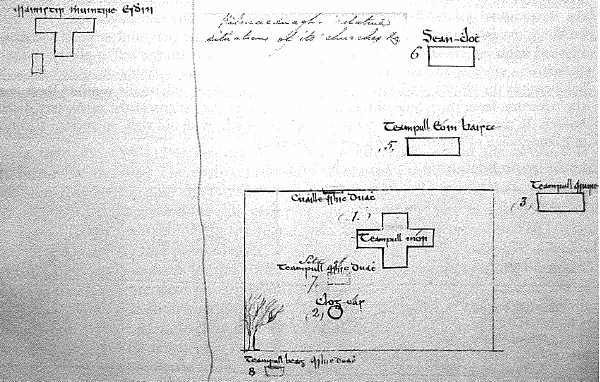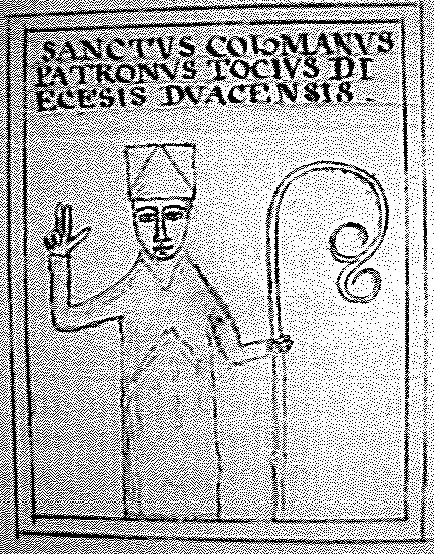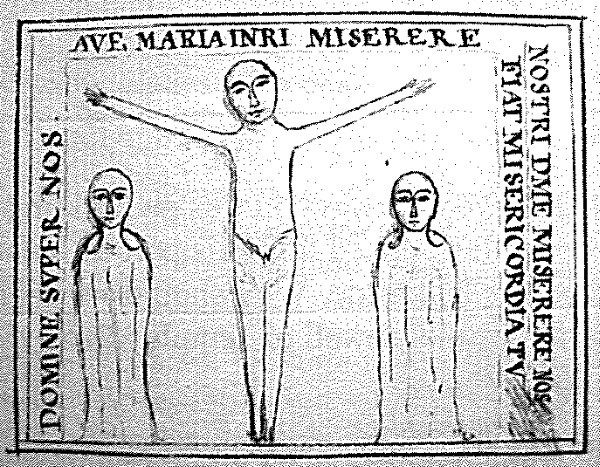Go to Page
[Hand of J. O'Donovan:]
Dear Sir,
You will now observe that we have just done here. We expect to be able to move to Mountrath in the Queen's County on next Wednesday or at furthest Thursday, and I think that the sooner the name books &c. are sent thither the better. O'Keeffe is getting on very well but his feet are as yet tender, and the night work is too severe for him.
OF THE PARISH OF KILMACDUAGH
This parish lying to the South-west of the town of Gort and verging on the Barony of Burren in County of Clare, is called in Irish Cill Mhic Duach, which means the church of Mac Duach, that being the patronymic name of (St) Colman, the first bishop and patron of the diocese of Kilmacduagh. This great man flourished about the year 620; he was of noble origin being nearly related to
Guaire, King of Connaught, whose name is rendered immortal by the Irish Bards for his unbounded hospitality and bounty. Their relationship to each other will be seen from the following table
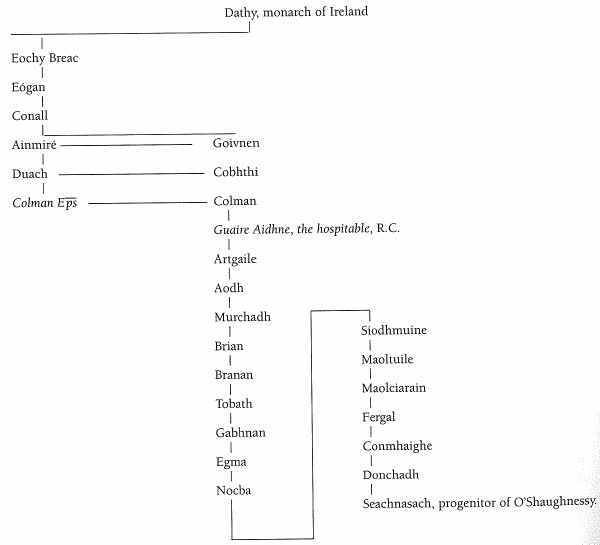
I here insert what Colgan has collected about the history of St. Colman Mac Duach.
[Hand of Patrick O'Keeffe]
KILMACDUACH (Barony of Kiltarton)
OF S. COLMAN, COMMONLY {CALLED} MACDUACH
III. February. From various. {AA.SS. p. 266, Col: a}
I. In the Southern districts of Connaught in the time of Aidus the second (1) King of Ireland there flourished a man distinguished by ancient nobility, and the splendour of his virtues, by name Colmanus, by cognomen Macduach. But that cognomen was taken from his father Duach. For Mac-duach in Irish signifies the same as the son of Duach. But since in the same country most prolific of (in) holy men, and even at the same time there existed very many of this name (2), or Colmans, conspicuous by the fame of their sanctity, therefore this holy man began to be called Colman Macduach for the sake of removing ambiguity (3)]; but the surname afterwards by vulgar (common) use so took the place of the name, that it would have plainly (evidently) extinguished it, had not the ancient monuments of the Country preserved from destruction to posterity that {which is (was)} now (already) almost dead among the people (vulgus).
II. Moreover this Duach, the father of our most holy Colman, was the son of Anmireus, deriving his origin (extraction) from the most noble family of the Hy-Fiachra. For from the stock of Fiachra, who was the son of Eochy Moimedhoin (King of Ireland) and the father and founder of this family sprung two Kings of all Ireland, and many Kings of Connaught, and very many men conspicuous for the fame of their sanctity, among whom, by the title of the singular prerogative, by which he merited to be held as the common patron and tutelary Saint of his entire family, our S. Colman obtains the first place.
III. This extraordinary man (having) from his early age followed the camp of Christ, at length betook himself to a solitary place far from the intercourse of men, where he began to consecrate himself entirely with the most ardent affection of his soul to the exercises of heavenly virtues. ***
IV. V. {these chapters contain the account of the Saint's mouse, cock and fly, as given by Keating, {quem vide}}
{p. 244 col. b} VI. But the fame of the virtues of Colman increasing more and more every day, at length he is forced to the public care of souls, and is created (8) Bishop against his will. ***
Wishing therefore to shun the blast of the vulgar (public) breath, and to devote himself entirely again to the contemplation of heavenly things, having resigned the Episcopal office, he betook himself a second time to solitude, and began to inhabit a deserted {spot} in the Southern districts (parts, finibus) of Connaught, having fixed his dwelling near a pleasant fountain in the great grove (wood) of Boireann, and {in} that part of it which is called Kinn-aille, about five miles from Durlus (a Durlussic), the palace of Guaire King of Connaught. But the holy man was nearly related by blood, and afterwards by religious intercourse most united to this most celebrated King Guaire, whom our histories and the mouths of the people have rendered
of eternal memory on account of his profuse bounty towards the poor and the needy and the renown of his incomparable (incomparabiles landes) liberality and piety, so that it has become a vulgar proverb among the Irish, when they wish to praise any person for his distinguished liberality; He is more liberal than Guaire.
VII. But what the faithful servant of Christ, and distinguished pursuer of an anachoretic life, and through him the virtue (power) of Christ did in that solitary place, S. Aengus in his additions to his Menologium, or his scholiast in the same place compendiously relates. On the third {he says} of February Colman the son of Duach, from whom the Church of Kill-micduach received its denomination. This Colman betook himself to a hermitage lying in the wood of (10) Boireann Chonnacht, accompanied by one clerical disciple. But they went thither in the time of Colman ({lege Guaire(?), POK}) surnamed Aidhne; and there they remained seven entire years, receiving no sustenance
from any person in the mean time, admitting conversation with no one. They built there an oratory surrounded with trees (sylvis, woods); they were clad with the hides of stags; their food was water cresses and wild herbs; cold water their drink, that dis-ciple of the man of God was at the same time the cook, steward, and vicar of that hermitage.
{p. 245, col. a} VIII. But Saint Colman having gone through the Lent, on the joyous solemnity of the very Sunday of the resurrection after having performed the divine office, says to his disciple from the abundance of spiritual joy; today is the great (Paschal) solemnity; Behold now the ministers of divine {things} are to be treated in joy: namely I {who am} Archennach, priest, and Bishop; {&} you, in whose hands is the whole disposition (arrangement) of matters (affairs); you ought to be liberal in this great solemnity of Jesus Christ the Son of the living God. To whom the disciple answered: matters shall be well Father;
but first perform the divine mysteries; which when you have dispatched go to the refectory; there is a good provision, which cannot be concealed from the ministers and friends of divine {things}, viz., a little bird which I caught in the wood with snares (laqueis), and {which} I prepare with the herbs of the wood, to be laid before your Fathership on so great a festival. Then after the divine office and the most holy sacrifice of the Mass was (were) celebrated they proceed to the refectory; and that portion being prepared is laid before the servants of Christ spiritually rejoicing in the Lord. Whilst these things take place in the desart (eremo), a dinner is prepared and served up to the table of King Guaire in the palace of Durlus; and among other things, for the sake of more plentiful refreshment, a boar and a stag are served up on large chargers, which the servants carried {by means of} two great bars passed through their four handles. But the pious King when he beheld the viands
{which were} served up, says, Would that that refection, if it pleased Christ, were with some more needy servants of Christ, since the like are not deficient with us. And when he said these things; immediately a wonderful circumstance occurs. For these (those) dishes being at once borne away through the air are gradually removed from the sight of all. But King Guaire astonished at the novelty of the matter orders his horses to be brought forthwith, and follows whither those viands seemed (were seen) to be borne. But they by the ministry of Angels are carried across the plain of Aidhne as far as the refectory, in which S. Colman was conversing (engaged, versabatur) with his disciple. Which having seen the disciple, says: behold, holy Father, the reward of your patience and forbearance; eat cheerful of the provision mercifully sent by the goodness of God. But the holy man refused to touch it, until he could learn from whence it had been brought. Wherefore fixedly viewing those
dishes with admiration he says: O dishes who has carried you across Luania {which was the name of the surrounding wood}? to whom the voice of an Angel answered: your prayer, and the pious liberality of Guaire. Whilst Colman and his disciple remained thus pouring forth praises (in laudens effusi), King Guaire with his court comes up, and says to the men of God: you are caught. To whom Colman says, so it has pleased God. And when the King asked how long they had lived in that solitude; they answered that they continued in the same place seven years and forty days. It is time, says Guaire, that you eat of the dinner sent by the grace of God. The holy man asks who he is, who orders these things? The King answered, that he was Guaire from whom also (both) those viands had come, and who humbly asked (requested), that the servants of God would be refreshed with the same; moreover offering the spiritual care of his life to S. Colman, and his body after death to be buried in his Church.
The holy man holding most grateful that eminent piety of the King, says, your devotion shall receive {its} reward from God. Then the most pious King determined to build a church in that place for the man of God; wherefore on the morn' of the following day he sent to him sixty cows after waiving (effaetas), together with men and maid-servants to perfect the work of the building. Therefore on the day following that day the building of the Cathedral Church of Kill-mhicduach was commenced; to which from that time the burial of the Chiefs of the territory of Aidhne, and of the stock of Guaire was consecrated.
IX. These things almost to a word from the cited Menologium; which however are related a little (somewhat) differently in a fragment of the life of this Saint, which has come to my hands from a (the) MS. (book) of Donegal. ***
{this fragment describes the Saint's hermitage, thus}
{p. 245, col: b} He went therefore to a certain vast and very dense (thick) wood of Connaught; in which not far from a rough and rocky mountain, he built an
oratory and eremitic cell; and there he spent 7 years. ***
X. XI. {The account of Guaire's feast, &c. is given without any important difference until we come to (where) the King has set out to pursue the dishes.} ***
{XI.} Thereupon he {Mac-duach} orders his companion, having laid aside his diffidence and imbecility of mind to eat of the food which divine providence sent. Which when he consented (assented) to do, he sees opposite him on the neighbouring mountain several troops of horse and foot (running up in every direction), and a numerous crowd of people promiscuously mingled following them; and he remains anxious and disturbed by that sight, fearing that violence would be offered to him & his holy Father. Which seeing the servant of Christ confiding much in his Lord, orders {p. 246, col: a} in the virtue of God, that they should not approach nearer, or move their feet from the spot, until his dis-ciple would satisfy the necessity of nature from the viands laid before him, and prove, that they were not fantastical (phantasticos) ["Are ye fantastical or that indeed which outwardly ye shew." - Banquo to the Witches, Macbeth, Act I. Sc. III.], but real which the bounty of God provided; who
not from any want, but from the hidden design (counsel) of his wisdom, wishes to have his servants' needy and hungry, {intending} to recompense their hunger and want with the abundant delights as well as riches of eternal glory and of the heavenly kingdom. A stupendous matter; the horsemen remain fixed, the footmen remain fixed, the dogs and horses stand still; nor could they move their step forward or backward, until the intercession of the pious King Guaire prevailed with the servant of God, that all should afterwards be sent away free. In perpetual memory, and confirmation of so great a prodigy, there are said to exist even to this day, cut out and formed in different parts of that rocky mountain, the tracks, which the feet of the men and dogs and the iron shoes of the horses left impressed in (on) the rocks to the admiration of spectators; and the way itself having obtained
its name from this wonderful event, is commonly called even to these times Bothar leanta na mias, that is, the road of searching (pursuing, investigandarum) after the dishes.
These things {are} faithfully taken down as to sense from the cited fragment, which {things} also in almost the same manner Keting hands down in his above cited history of the Kings of Ireland, unless that he is silent {with regard to} {those things} which are here related concerning the tracks (foot-steps) of the horses and dogs impressed in (on) the rocks; and adds that S. Macduach, whom he erroneously calls Mochua, was the brother of King Guaire; which cannot be consistent with the rest of the histories of the Country, unless, using a vulgar phrase, by brother he understands relative, as will appear in the appendix chap. 1. But from the ciuaed fragment receive the following, moreover, concerning the man of God.
XII. When the pious and gracious King Guaire saw that so great, miracles were performed by the holy man who was most intimately united to him both in blood, & friendship, he offerred [sic] to him most ample gifts, and whatever lands he wished, to be turned to pious uses. But the eminent despiser of the world wished (was willing) to accept none of the things which were {so} liberally offered, except a place fit for building a cloister (asceterium); which he was even then unwilling to point out, until indeed he would first consult the Lord, and learn from him, where he wished that his servant should fix his abode (pedem figi), or build an oratory to the praise and honour of the divine name. But afterwards he was admonished from heaven concerning building a cell in that place, in which first his Zone or belt (girdle) should fall on (to) the ground. But when on a certain occasion he was walking through
the wood his girdle fell in a certain place not far removed from his former dwelling, and there he built a cell, which from his name was commonly called Kill mic-duach, and which afterwards being endowed with many farms (pradiis) by King Guaire, and his successors, was elevated (erecta) into the Episcopal See (12), which at the present day by syncope is called in Latin Duacensis.
XIII. But that girdle, of which we have just made mention, being afterwards held in the highest esteem, in honour of the sacred body which it had bound, {and} imbossed with gold and gems, is preserved in the highest (greatest) veneration, as a sacred patrimony, and a symbol of ancestral virtue (Walker) even to this day by the illustrious, and of most ancient nobility, family, of O'Shaughnessy, which descends from the seed of the aforesaid King Guaire. Concerning (de quo) which {belt} among the many kinds of cures which by the wonderful
and truly singular clemency of God are exhibited by means of it, that remarkable and continually memorable {fact} occurs, which frequent experience proves. For any person, however corpulent or fat, who has preserved his virginity untainted, can gird, and bind himself with it; but he, who has violated his virginity in any {respect} be he ever so tender in age, or slender or lean in body, can never close (draw) it round him, {p. 246, col: b} or enclose himself in it; so indeed that the sacred girdle of the most chaste loins of the blessed man disdains to admit within it any others, but those smelling of the flower of undefiled chastity. Hitherto the cited fragment.
XIV. Moreover the Church built by the servant of Christ grew (has grown) to such a pitch of dignity and celebrity, that it was (is, haberetur) considered (& was (esset, is)) the common and most safe asylum of the country; the immunity of which nobody doubted (would doubt) to be so protected by the divine majesty through the merits of his (its) servant, that it wonderfully defended (would miraculously defend)
it {when} wickedly attacked, or avenge it {when} sacrilegiously violated, with present punishment. The reverence also of the place has (been) increased by a certain tree planted not far from the Church itself by the holy man, which they commonly call Cuaille Micduach, that is, the pole (stake) of Macduach. He who having placed his confidence in the Saint devoutly carries, or has in his possession (pines, about him) a bough cut from it, or any piece {of it}, escapes the most immediate dangers of death; as the continual (constant) tradition hands down (habet).
XV In fine, although it is certain that this holy man flourished in the time of King Guaire, who, according to our historians everywhere, flourished about the year 630 (13), however it is uncertain in what year he departed. But his birth-day, according to our (14) Hagiologists in common, is placed on the 3rd of February; although I understand that his festival is celebrated throughout the entire Diocese
of Kill-mhic duach not on that day, but on the 27th of October from constant tradition. But on that day our Calendars (15) place not his birth-day, but that of another most holy Colman called Hua-Fiachrach, that is, of the stock of Fiachra; and they say that it is celebrated not in Connaught, but in the territory of Leinster called Hy-Kennselach, in the Church of Senbhotha. This confusion perhaps arose from the circumstance that the name of both Saints is the same, and {that} both being sprung from the same family, flourished about the same time. For Colman Hua Fiachrach derived his origin from the aforesaid family of the Fiachrians, as the very annexed appellation sufficiently indicates, and our (16) other histories testify, and flourished in the year 620, as we will show in the notes (17). However it be S. Colman Bishop is ({held}) in such veneration and honour throughout the
entire Diocese of Kilmacduach, and particularly with the illustrious family of O'Shaughnessy, that not only is his festival celebrated in choir, i.e., I suppose in the Church and among the people (in public, choro & foro) and market-place with great veneration, but also the day before his festival is observed most strictly with a vigil and Ecclesiastical fast; so that they abstain not only from flesh, but also from eggs, white-meats, and all viands prohibited in Lent; and (it is believed that) he who would act (do) otherwise is not only guilty of mortal stain (sin), but moreover that he will be punished by divine justice, with the most immediate vengeance.
{Colgan then gives an account of some miracles performed (in or about his own time) by the virtue of the Church & tree of S. Macduach and among the rest he mentions that}
There was a man in Thomond condemned to death for some crime, who was hanged three times and yet was found living; upon examining his body, they discovered that he had a portion of the tree of S. Macduach in his mouth, which was immediately taken out. He was again brought to the scaffold, & in due time was found to be perfectly dead. The Judge who condemned him was alive in 1629, "and perhaps lives yet" {1645} says Colgan.
NOTES
1. Tempore Aidi secundi &c. This was Aidus or Aedus the son of Anmirius, who after he had reigned twenty seven years fell in the battle of Belach duin in the year 594. Since therefore Saint Colman flourished in the time of S. Columb-Kille, who died in the year 592, as appears from what is said above in his life, it necessarily follows that he lived in the time of this Aidus.
2. Permulti extiterunt hujus nominis sanctitatis laude conspicui, Cap. 1. Among these, that I may pass by (omit) others, the Four Masters in the Annals make mention of the following and observe the year of their death in this manner: S. Colman the son of Lenine died in the year 600. S. Colman Ela, who {is} also {called} Colmanellus in the year 610. 26t" of September; S. Colman the son of Comgall in the year 620; S. Colman Huabardani Abbot of Clonmacnoise in the year 623. S. Colman Stellan Abbot of Tirdaglass 625. S. Colman Abbot of Clonard, and afterwards Bishop in the year 652. S. Colman Abbot of Glendalough in the year 659, on the 2nd day of December; S. Colman Hua Cluasaigh in the year 661.
3. Aequivocationis tollendae causa &c, Cap. 1. The ambiguity (aequivocatio) was on account of so many Colmans, just now cited, of the same country, and almost age, and particularly on account of another Colman {who was} a relative and co-temporary of this {saint}; of whom below 17) num. 17.
4. 5. 6. *** 7. *** 8. Episcopus creatur, Cap. 6. In the Martyrology of Donegal he is called Bishop, and in like manner by S. Aengus, or another in the additions to his Festilogium he is called Bishop; and that whilst he was as yet in the wilderness (Eremo) of Borenn, and before he had erected the Church of Kilmacduach, of which he was the first Bishop.
9. Sanguine propinquus regi Guario &c, Cap. 6. For Guaire was the son of Colman, the son of Cobthach, son of Gobnin, son of Conall according to the List of the Kings of Connaught; but Colman was the son of Duach, son of Anmirius, son of the same Conan, according to what is to be said in the appendix Chap. 1, so that the latter is three {and} the former four degrees removed from the same root (stipite) {stock}.
10. In saltu de Boireann, Cap. 7. For many years back this wood and the territory of Thomond in which it is, belongs to the right of Munster; but formerly the entire of that territory was reckoned among the territories of Connaught according to our antiquaries in common. 11. ***
12. In sedem Episcopalem quae hodie Duacensis nuncupatur, Cap. 12. It is commonly (vulgò) indeed called Kill-mhic duach, but in Latin every where, and in the Roman register Duacensis.
13. Qui floruit circa annum 630, c. 15. Keting in the place above cited {reign of Aedh the second} indicates that Guaire was King of Connaught in the time of Diermitius the first, King of Ireland, who died about the year 558; but the Annals of Donegal from {those} of Clonmacnoise, and of the island, and of Senat, assert that he flourished in the year 640, and died in the year 660. Whatever be {the case} with regard to the year of his death, it is more in accordance with the generality of the historians of the country that he did not flourish, or at least was not King in the year 558; but indeed about the year 630 as we have said above.
14. Juxta nostros communiter hagiologos ponitur 3. Feb. Cap. 15. Thus at the same day the Martyrology of Tallaght: {The feast} of Colman the son of Duach, Marian Gorman Mac-duach or the son of Duach, the protector from adversities, Colman the hospitable and generous. The Martyrology of Donegal S. Colman Bishop the son of Duach of Kill-mhic-duach. Likewise Cathal Maguire on the same day.
15. Ponunt nostra Menologiae, Cap. 15. Thus with the four last (just) cited S. Aengus and the Calendar of Cashel.
16. Et aliae nostrae testantur hystoriae, Cap. 15. Thus the life of S. Fidmunius to be seen at the 16th of May.
17. Floruit anno 620 Cap. 15. It is thus collected from the cited life of S. Maidoc, in which that S. Colman is said to have been the co-temporary of S. Maidoc; but S. Maidoc died in the year 624, according to the Annals of the Four Masters, but according to Usher in his Chronological Index, in the year 632.
APPENDIX
{p. 248, Col: a} *** Chap. I *** His genealogy is thus given in the Menologium genealogicum, c. 9 S. Colman Bishop of Kill-mhic-duach, the son of Duach, the son of Anmire, son of Conall, son of Eoghan, son of Eochy breac, son of Dathi or David, son of Fiachra, son of King Eochaidh &c. And this same in the same terms is given, metrically put together, in the book of Leacan. ***
{FROM THE) LIFE OF S. MAIDOC OF FERNS, FROM THE BOOK OF KILKENNY; SUPPOSED TO HAVE BEEN WRITTEN BY S. EVIN
AA.SS. p. 213, Col: a
{Chap.} XLI. At a certain time the most blessed Maedoc wishing to go to the regal city of the Momonians namely Cashel, the horses of his chariot stood immoveable, after the manner of Baalam's ass. The holy man wondering at this an Angel of the Lord came to him saying to him: The Lord wishes, that you should go to another district .i. to the province of the Connacians, because Guaire Aidhni (38) King of the Connacians is tortured with most severe pains in the cell, which is called Keall mic Duach (39) he is now tortured [In left-hand margin: {tautologia in orig:}] almost to death; but the Lord grants to you to cure him. The man of God answered: whatsoever the messenger of my Lord says to me, I shall willingly do. Then I wish {you} to go thither said the Angel; although you are (be) unwilling, however you shall go; because so the Lord wishes; and your horses will not go through {any} other way. Then S. Moedoc said to his charioteer: allow the horses to go wherever they wish. And immediately the horses turned (bent) their course to
the north, and when they came to the lake Dergderc, the horses by the divine power proceeded without impediment under the chariot with (on) their feet through the lake, as if through dry land. Afterwards having crossed the lake, they found two men in a field; to whom S. Moedoc says: Show us a good way (road); who answered, in these places there is no road. One of them (eorum) said to them (eis): if ye are good clergymen, ye will make a level way of rough places. Then the Holy Elder Moedoc says, blessing the way: the Lord knows how we are; but he can make a level road for us, as you say. At this expression a level way was made through the mountains and woods, and bogs without any impediment as far as the Monastery, which is called Keall-micduach, where the King of Connaught Guaire Aidhne was sick. And when a prayer was made for him by the holy Bishop, he was immediately healed from all his infirmity. And the holy man says to the King: you shall hold your Kingdom again thirty years (39), and in the end of your life you shall be three years in pain, and in that infirmity you shall die, and you shall possess the Kingdom of
Heaven on account of your bounty (eleemosinam) and liberality (largitatem). For the King could fulfill that sentence, which says: Omni petenti te da. And blessing the King, and having made a prayer, and an established (firm) friendship between himself and the most holy man, in honour of whom that Monastery (40) and town was (a singular idea; so in orig.) first built, the most blessed man Moedoc departed (retired) on his journey.
NOTES
{p. 219, col: b.} 38. Quia Guarius Rex Connactorum Cap. 41. This is that celebrated (famous) Guaire the son of Colman, who is not only much celebrated (not only) in our histories, but even to this day; so notorious even among the people on account of the prerogative of his distinguished liberality, that when any one wishes to extol another for his liberality he says: he is more liberal than Guaire himself.
39. In cella quae dicitur Kill-micduach, Cap. 41. From this place you will collect that the ancients were accustomed to call great Churches, even Cathedrals cellas. For the Church of Kilmacduach, which is here called a cella, is a Bishop's See in the County of Galway in Connaught; as Kildare & Kilkenny in Leinster, and Kilmore in Breifny.
39. Regnum tuum iterum tenebis triginta annis Cap. 41. According to this they err, who say that Guaire reigned only 21 years, and much more others, who relate that he only {reigned} 15 years; and the opinion of others is more correct, who attribute to him thirty eight years of a reign. But these things notwithstanding do not agree with those {things} which the Four Masters in the Annals hand down concerning
the death of Guaire and of S. Maidoc in the Annals in which they write that S. Moedoc died in the year 624, but Colman in the year 662. For so, Colman (a nullus error) would live not only thisty years after he was cured by S. Moedoc, but thirty eight years after his death. Whence I think that they erred in the year of the death of this King, which, as is collected from this life, happened in the year 642, or the year preceding.
40. Et facta oratione & firmitate inter se & sandissimum virum, in cujus honore est illud Monasterium Cap.
41. The discourse is here about S. Colman the son of Duach, who is (was) both the founder and patron of that Church; and is called by another name taken from his father, Macduach that is the son of Duach; whence this Church is called Kill-micduach. See the life of this S. Colman at the 3rd of February
[There is no page 145 in the manuscript.]
[Hand of J. O'Donovan resumed:]
These legends are curious as shewing the state of human knowledge in Ireland when they were written, in that all believing age when the laws of nature were changed at the beckon of ecclesiastics!
The modern investigator of the truth of the history of Christianity in the middle ages, has to lament that he has little to take hold of but supernatural occurrences, which though they never occurred were as firmly believed to have occurred as the cutting of a throat or the robbing of a termon; and that all he can believe of the narrative of the Hagiologist is the time, person, and place, and now and then some references to dress, manners, customs and laws.
The great object of the Hagiologist was (however) to sum together as many instances as possible of the success of his hero in prevailing on God to change his "fixed and immutable laws", and (what is more to be lamented) the modern investigator finds himself often puzzled whether to believe or reject even what the hagiologist has put in the shape of every day occurrence; for, he finds that almost every life of a saint was written by some member of his ({the saint's}) own family for the purpose of gaining a certain object, and to this
end, great personages are brought together on the stage, which were not contemporaneous (and occurrences and mixed modes are attributed to early ages which belonged to the age of the writer only) and when the stream of received history made (it) difficult for the writer to bring such personages together, he had no scruple in awak[en]ing some of them from the tomb. This is a melancholy fact! and still we must leave the history of the dark ages unwritten unless we take the trouble to sift and analyze the strange materials left us by the literati of these all-believing times. Modern sacred history is a narrative of (certain supernatural operations of) miracles, by which it pleased God to confound the wicked, and to encourage the true believers to persevere in their works of piety and austerity, and to confirm those who doubted, in the faith; but though the pious writers of such miracles had no real evidence to support the fact of a single instance of a change in one of the fixed laws of nature {which the evidence of all men assembled together would scarcely be sufficient to prove} still in putting together the details of the narratives they generally refer to facts and "mixed modes" of the ages in which they lived, which the modern investigator can receive, with considerable safety, as true history. So much from me, lest any one might be so foolish as to think I believed the "story of the dishes".
Parishes of Kilmacduagh, Doorus, KinvAra and Killinny
Ages of the Cathedral of Kilmacduagh, and of the old church of Killinny considered; theories &c, &c.
This letter commenced at Gort and finished at Mountrath.
ANCIENT REMAINS AT KILMACDUAGH, WHICH LIES 3 MILES S:W: OF THE TOWN OF GORT
(1) Templemore or Cathedral (see sketch). This is a very curious building, and affords a wide field of speculation to the antiquarian in consequence of its having been repaired and remodelled more than once. In its present state it is a building of considerable extent measuring 34 paces from the west to the east gable and 21 feet in breadth. It consists of a nave, a choir and two (aisles or) transepts. The choir is 27 feet long and 21 broad. The choral arch is semicircular at the top (about 20 feet high) and 15 feet broad at the base. The transepts are small but neat chapels with beautiful windows in the pointed Gothic style. The arch way leading into the South transept is pointed and of considerable height. That leading into the north one was originally a high pointed arch of good but rough masonry, but it was afterwards stopped up and a small doorway formed about the height of a man and semicular (semicular?) at the top. The east gable contains a large Gothic window, and the west gable a square window and a doorway in the Semi-Cyclopean style, both now stopped
up with masonwork. The south side wall contains a (neat) doorway in the Gothic pointed style, and near it immediately to the east a small window {much injured} of this form  and not unlike one of those in the round tower standing opposite.
and not unlike one of those in the round tower standing opposite.
This church was unquestionably remodelled in the 14th or 15th century as the antiquarian will see by an examination of the different parts of it. The west gable is in the primitive style of masonry excepting a small portion at the corners where it was widened in the 14th or 15th century. The two side walls are also in the large semi-Cyclopean style from the west gable as far as the choir arch {an extent of about 75 feet} where modern masonry commences and extends to the east gable. From this it may be inferred that the Cathedral was originally 75 feet long and 21 broad. The doorway in the west gable is certainly the original one. It is in the semicyclopean style, measuring 6 [feet] 2 [inches], in height, and 2feet. 7in. in breadth at the top, and 3ft. 0in. at the bottom. The doorway in the south side wall is decidedly modern and evidently inserted at the (time that) the building was enlarged and remodelled, when the western door was stopped up (see my letter on the old Church of Kilgeever near Croaghpatrick, the west doorway of which is also stopped, and a pointed doorway in the south wall) to agree with the custom of that age.
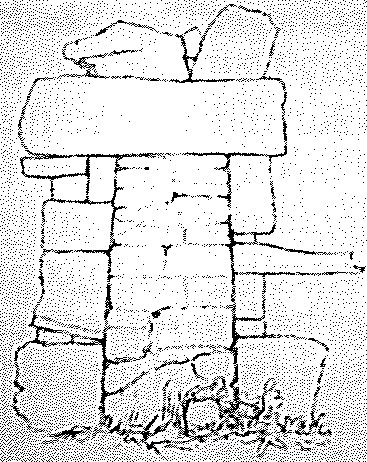
Breadth... 4ft. 2inches.
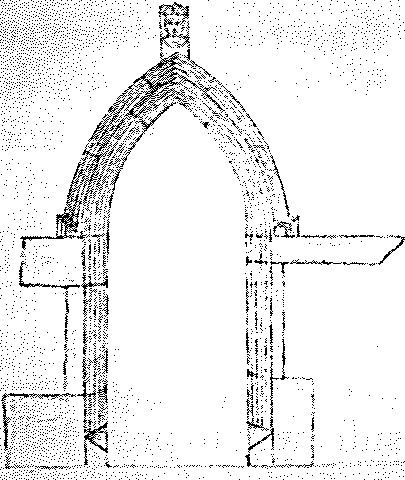
I think that there can be very little doubt that this beautiful doorway is 500 years more modern than the one in the west gable, which is (nearly) in the same style with the doorway of the round tower.
A question here presents itself to the investigator of (the) truth: are the west doorway of this church and those parts of the west gable and side walls which are built of large stones, some of the building erected for St. Colman himself? This question cannot be easily answered, as the (written) authorities do not agree on the subject, for it would appear from (a fragment of) an ancient life of St. Colman published by Colgan from the Donegal MS. that the saint himself never erected any more than a cell at this place, while the Scholiast of Aengus asserts that he built a Damliag or Cathedral. The following are the words of the Donegal MS:
When the pious and gracious king saw that such great miracles were performed by the holy man, who was most intimately united to him both in blood and friendship, he offered unto him most ample gifts, and whatever lands he wished to be turned to pious uses. But the eminent despiser of the world was unwilling to accept of any of the things
thus liberally offered him, except a place fit for building an asceterium (cloister); (even) which he was then unwilling to point out, until he should first consult the lord, and learn from him, where he wished his servant to fix his abode or build an oratory to the praise and honor of the divine name. He was afterwards admonished from heaven concerning the building of a church in that place in which his zone (or belt) should first fall to the ground. And when on a certain occasion, he was walking through the (a) wood, his girdle fell in a certain place not far from removed from his former dwelling, and there he built, a cell, which from his name was commonly called Kill mhic Duach, and which afterwards being endowed (with) much land by King Guaire and his successors, was elevated into an Episcopal see.
The Scholiast of Aengus, however, positively states that the Cathedral church of Kilmacduagh was built for St. Colman himself. After telling the story about King Guaire and the dishes, he goes on:
The holy man holding most grateful that eminent piety of the King, says, your devotion shall receive
its reward from God. Then the most pious king determined to build a church in that place for the man of God; wherefore on the morning of the following day, he sent him sixty cows after calving (in calf) together with men and maid-servants to perfect the building. Therefore on the day following that day the building of the Cathedral church of Kill-mhic Duach was commenced; to which from that time the burial of the chiefs of the territory of Aidhne, and of the stock of Guaire, was consecrated.
Here there are two (written) authorities in opposition, and nothing remains to decide but the monuments themselves. The west gable of the Cathedral and part of the side walls certainly appear ancient, but the breadth of the building {21 feet} compared with other ruins of undoubted antiquity makes me incline to think that this Cathedral was not erected for a couple of centuries after the death of St. Colman, when this establishment rose to greater importance. Tradition is positive in asserting that Temple mic Duach, which was the one erected by the saint himself stood to the S.W. of the Cathedral and north of the round tower.
By comparing this Cathedral with Bishop Mel's church at Ardagh, one must come to the conclusion that they do not belong to the same age, the difference of size is so very great, and still both were Cathedrals! There were nearly 200 years between Mel and Mac Duach, but this is not enough to account for the difference of size and character of masonry. I must therefore persuade myself that this Cathedral is the work of the 8th or beginning of the 9th century, but let others more skilled in this kind of knowledge come to a conclusion more favourable to the respectability of old Irish churches.
(2) Clogcár, or Round tower. This is said to be 120 ft. in height and 60 in circumference (at the base). It is in good preservation though (according to Archdall) it leans (nods to the S:W:) 17½ feet from the perpendicular, 4½ feet more than the tower of Pisa so celebrated by travellers. (This is not true. It has bee proved that this tower leans only two feet from the perpendicular. J.O'D.) It (is) split on the South east side, and one thunderbolt wd. (will) soon lay it prostrate. It is evidently of the same age with the doorway in the west gable. Its doorway which is 15 (16) feet from the ground faces the east, is semicircularly formed at the top, and wider at the bottom than where the arch begins to be formed, which last (characteristic) is certainly one of those
distinguishing the (doorways of all the) Irish churches of the primitive ages that I have ever seen. All the windows of this tower agree with my characteristics of the primitive windows, namely that of being rectilineally pointed at top.
The north east part of the Beann-Chobhar or conical cap of this tower is a good deal injured, and there is no use in repairing it because the whole tower must tumble in less than a century, that is 62 years before the day of judgement.
(3) Templemurry or our Lady's church. This church wch. is situated a short distance to the N.E. of the Cathedral, is 43 feet long and 20ft. broad. The south side wall contains a doorway (which) is semicircularly formed at the top, 6ft. 3inch. high and 3ft. 9in. wide. The wall is 2ft. 7in. thick and the (external part of) the doorway 1ft. 7½in. thick. The internal part of [the] doorway is covered at top with a lintel 7ft. 6in. from the ground. The sides of this doorway are parallel to each other, which shews that it differs in a striking characteristic from the doorway in the tower and west gable of the Cathedral, which have not the sides parallel. The South side wall also contained a lancet window now much destroyed, which was 5ft. 0. broad inside and 9 inches broad on the outside, but the height cannot be ascertained. The east gable contains a window in the pointed style, broad and pointed inside, and narrow and pointed outside. External height 5ft. 8½in. internal height 8ft. 10inches. External breadth 73/4 inches. Internal breadth 5ft. 0in. By comparing the internal and external breadth of this window with
that of the mutilated one in the south wall one will see at once that they were of the same size and form. I have seen other churches in which the window in the south wall was exactly of the same size, form and features with the one in the east gable. See Letter on the old church of Kilclooney near Ballinasloe.
The west gable of Teampull Muire is destroyed except (all to) 8 feet from which it appears that it never contained a door-way. The north wall is featureless.
Is this church of our Blessed Lady one of the primitive churches of Kilmacduagh, and as old as the west doorway of the Cathedral? I would swear by the girdle of Mac Duach that it is not! And this for many reasons: in the first place, its walls and features do not bear the impress of age, in the second place, the doorway is formed of materials too slender to have withstood the ravages of time (shock of elements) since the days of Mac Duach, and (thirdly) all the Temple-murrys in Ireland are modern as far as I have seen. Q? Have we any authority to prove that the primitive Irish Saints dedicated churches to the Blessed Virgin? I never met any, and I fear that we have none.
What age then, is this church of our Blessed Lady at Kilmacduagh to be referred to?
It cannot be older than the 13th (12th) century. Why then is the door-way in the South side wall semicircularly formed at the top? The Irish continued to build the doorways and windows of lheir churches in the round style long after the introduction of the Gothic style among them by the Anglo- Normans. Of this we have a specimen at this very place, for the Monastery of Kilmacduach, to be mentioned presently, has all its windows in the round style though it was erected in 1283, a century after the introduction of the Gothic pointed style.
I should be exceedingly anxious for the honor of old Ireland and the glory of the Blessed Virgin, to whom I have addressed more than ten thousand Aves, to make this church an erection of Mac Duach's or of some Bishop who flourished 600 years after him, but I fear it was built long after the Synod of Rath Breasail. Is there a single church in Ireland called Teampull Muire unquestionably of the 5th, 6th, 7th, 8th, 9th, 10th, or 11th century?
I am most anxious that Mr. Petrie should put me to the crucible here.
Window in the East gable of Teampull Muire at Kilmacduagh. (See also in Vols. of Sketches.) This window is in the Gothic style and about 600 years old.
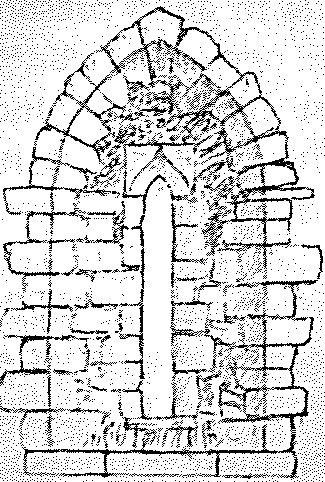
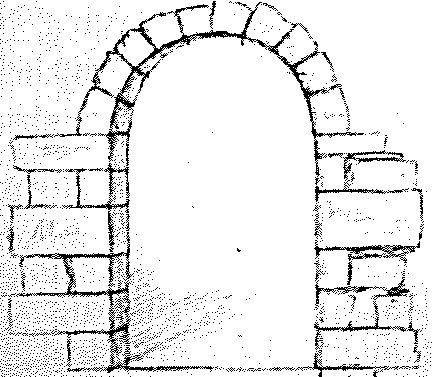
This doorway is round like some of those in the Abbey of Ballintober with which Teampull Muire seems coeval.
Compare this doorway wiuah those on page 3, and you will perceive that it is far more modern than the first and somewhat more ancient than the second.
(4) The Monastery of Kilmacduagh, now popularly called Hynes's Monastery.
Archdall has scraped together the following account of this building.
St. Colman, the son of Duach, founded an abbey here about the year 620, and Maurice, Bishop of this see, who died in 1283, erected on the ancient site a monastery for regular canons of the order of St. Augustine, &c.
This abbey is situated to the north west of the Cathedral on a neck of land between two loughs, which, according to some authors evacuate themselves into whirlpools; However this rarely happens as the water never goes off but in a very dry season {fool!}. The church though small (it is eighty feet long and twenty broad) is a very neat building; the pillars and arches from the entrance to the altar part, and those of the east window, are finished in an elegant style, and the angels at the west (end) are worked in pillars; to the south of the church is a sacristy, and adjoining to that a room where was probably deposited the valuable effects belonging to the church, and which being arched they call the jail; on the south of these is a chapel, and the refectory; from the whole of this we may infer that the canons of the monastery dwelt in separate houses. To the north about two feet fsom the old church, is an old wall; an ancient tradition still exists at Kilmacduagh of its being once a place of penance.
This quoted by Archdall from (Bp) Pocock's Journal.
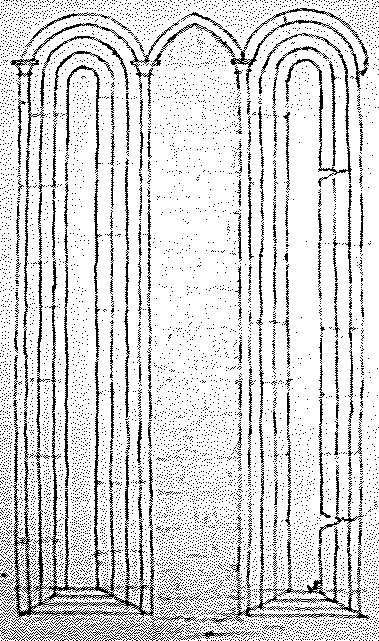
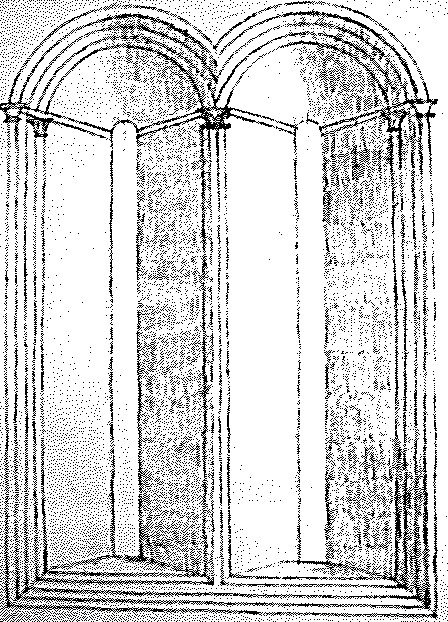
There are two doorways on this po building in the pointed style, from which we see that though the pointed style was introduced into this part of Ireland towards the close of the 13th century, the round style was not altogether laid aside. Why should we then wonder at finding a round doorway formed of slender materials in the south sidewall of Temple Murry even thought [sic] it is a church of the 13th century?
(5) This church lying N. by E. of the Cathedral is called by some St. Francis's church, by others the Church (see also in Vols of Sketches) of St. John the Baptist while others will have it to be called Teampull na naomh or the church of the Saints. It is perhaps 500 years old.
(6) Seanchloch, or House of the Clergy It is evidently of a more ancient date than Templemurry and No. 5. but scarcely as old as the round tower.
(7) Temple Mac Duach. This stood a short distance to the north of the Round Tower and to the S.W. of the Cathedral. It is all destroyed, but there are old men living, who remember to have seen parts of it standing. It was but a small building.
(8) Templebeg Mac Duagh, was situated (immediately) outside the wall which encloses the cemetery to the south west of the tower. The foundation is traceable, from which it appears that this (was) a very small building. Compare this (and No. 7) with Templekieran at Clonmacnoise. Tradition says that these two little churches are the two (only ones) erected by Mac Duach himself, which is probably true, and if so the (erection of the) Cathedral must be referred to a later period.
The story told above {pages 9 and 12} [i.e. MS pp. 126 and 129] is still vividly remembered in the Country, and the road of the dishes shown in a (mountain) valley in the townland of Sliabh-Carran, parish of Carran and Barony of Burren in the Co. of Clare. The people imagine that they see the impressions of the hooves of horses in, and soup and wine spilt (congealed) on the stones!
Tradition is positive in asserting that the Castle of Dun-Guaire near Kinvarra is the house in which King Guaire lived when he followed the dishes. This is however uncertain (there cannot be a doubt that Guaire's Seat was in the Townland of Dun Guaire at Kinvarra. J. O'D.) but I cannot decide it till I come to examine the Barony of Burran in the County of Clare, where Colgan places Derlus the p(a)lace of Guaire. One thing however, should be remarked here, that Colgan is wrong in placing the territory of Burren and the entire of Thomond in
Connaught in the time of Guaire Aidhne, for we do not find that any part of Thomond or north Munster was ever considered as in Connaught until the reign of Queen Elizabeth, when it was placed in it for political purposes. But O'Brien, Earl of Thomond afterwards prevailed on James I to have it made again a part of Munster {to which, he asserted, it belonged from all antiquity} because he did not wish to be considered a Connaughtman.
I must also remark that no part of Aidhne, ever extended into the Barony of Burren as can be proved from several authorities, and as appears at first sight from the strong natural boundary line between them.
There are two ruins of castles in this parish, (the erection of) which tradition attributes to the O'Shaughnessys, one called Clogh Maglynn, and the other the castle of Newtown. The former is a small insignificant (square) ruin, and was probably erected by the family of Maglynn as its name intimates; the latter is round and strong.
There are two holy wells dedicated lo St. Mac Duagh in this parish, one near the churches, and the other in the townland of Gortnacullia.
The remains of Cuaille mhic Duach or Mac Duagh's tree is built up in a (stone) ditch (cloidhe) a short distance to the north West of the Cathedral. It is still held in great veneration, and people carry small pieces of it about as preservatives against
accidents, but it is not lawful to touch it with a knife, {Compare with my letter on Kildare in which a long quotation is given from Cogitosus about the oak of Kildare}.
Cuaille mhic Duach is ash. It will soon be all cut away like the true cross, when, I hope, it will assume the property of vegetating (encreasing itself) without a root.
In this parish is situated the townland (of Rabha {Roo}) which is mentioned in the Annals of the Four Masters at the year 1599 as in the west of the territory of Hy-Fiachrach Aidhne.
In the townland of Teerneevin in this parish, the last O'Heyne held his residence. He is about 40 years dead.
OF THE PARISH OF DOORUS
This (small) parish lying in the N.W. extremity of the Barony of Kiltartan, is called in Irish Dubh Ros, which signifies Black point or promontory, a name truly descriptive of the townland in which the old church is situated.
The only antiquity in the parish is the ruin of the old church, which is said to be an erection of the 14th century It is very probable however that it occupies the site of a primitive church erected by Saint Breccan as there is a holy well near it dedicated to that Saint.
OF THE PARISH OF KINVARRA
This parish lying in the west of the barony of Kiltartan and adjoining the Barony of Burren in the County of Clare, is called in Irish Ceann Mhara i.e. the head of the sea. The old church of the parish is situated in the fast improving little (sea port) town of Kinvarra. It is in very good preservation, but certainly not more than 500 years old as any one will see by the form of the windows.
It is very probable however that it occupies the site of a primitive Irish church as it [is] dedicated to St. Coman who is said to be one of the primitive Irish saints. Perhaps he was the same saint that gave name to Roscommon?
Is St. Coman Cinn Mara mentioned in any of the lists of Irish saints?
I must here correct an error which I fell into in a former letter, namely that the point of Kinvarra is the Rinn Beara of Irish history. That place is in the South extremity of (the Bar: of) Leitrim, and is a point of land (in the townland of Garryeighter and parish of Clonrush) running into Lough Dergderc.
Kinvarra is in Irish Ceann mhara a name exactly synonymous with Kinsale.
In this parish immediately to the east of the town of Kinvarra, is situated the celebrated fort of Dun-Guaire within which stands a square castle in good preservation, said to have belonged to O'Heyne. Tradition says that the palace of Guaire Aidhne stood in this fort at the time that St. Colman Mac Duach lived in a hermitage in the Barony of Burren at the extremity of what they call Bothar na mias. If this be true it must be the Derlus Guaire
mentioned by Colgan, and in the poem addressed by Giolla Iosa Mor Mac Firbis to the O'Dowd in the year 1417. Colgan however seems to be of opinion that Derlus was in the County of Clare, but I am almost satisfied that he is wrong though I cannot finally decide, or pronounce any positive opinion on the point until I come to examine the County of Clare.
In this parish about a quarter of a mile east of the town of Kinvarra there is a holy well dedicated to St. Mac Duach. It is walled in, and shaded by some hawthorns and an ancient ash tree as usual with most holy wells in Connaught. Some think that St. Colman had a little church or hermitage here but I find no authority for any hermitage of his being any where, except in the Bar: of Burren where its situation is indicated by Bothar na mias.
OF THE PARISH OF KILLINNY
This parish lying to the west of Kiltartan is called by the Irish Cill Eithne, which signifies the church of the virgin Saint Ethnea or Inny. Is there any female saint of this name mentioned in the Irish Calendars or any other list of the old Irish saints?
The old church of St. Ethnea which lies about 4 miles to the north west of Gort {to the right of the road as you go to Kinvarra,} is one of the oldest churches I have yet seen. It is built of enormous stones, some of which are 4ft. 0in. long and 1ft. 10in. high, others 4ft. 0in. by 2ft. 6inch. and some 3ft. 0in square.
I studied this church for 2½ hours, and was never so puzzled in all my life as I was at the features it presents!
It measures on the inside 18ft. 4inches and in length 34ft. 0inch. The walls are 2ft. 8inch, in thickness and 8ft. 0in. in height. The west gable is now featureless,
and (the half of it) built of large stones. The south side wall contains a doorway in tolerable preservation on the inside but totally destroyed on the outside but from the form of the chiselled stones scattered on the ground near it (it can be seen) that it was of a pointed form on the outside. On the inside it is 7ft, 0inch. in height and 4ft. 6inch. in breadth, which is out of proportion to the size of the church, but it was evidently narrower and lower on the outside like the doorway of the Lady's church at Kilmacduagh. The lintel which traverses this doorway at the top is 7ft. 4inch. long,1ft. 4inches wide and 6 inches thick. The south wall also contained a lancet window which is now so destroyed that its dimensions cannot be given. The east gable which is a (good) deal injured contains a window in the round style broad (wide) inside and narrow on the outside, where it measures 3ft. 6inches in height and in breadth 5 inches at the top and 8 inches at the bottom. It is decidedly a primitive window which was never remodelled or repaired. {Compare with Kilroe near Killala}
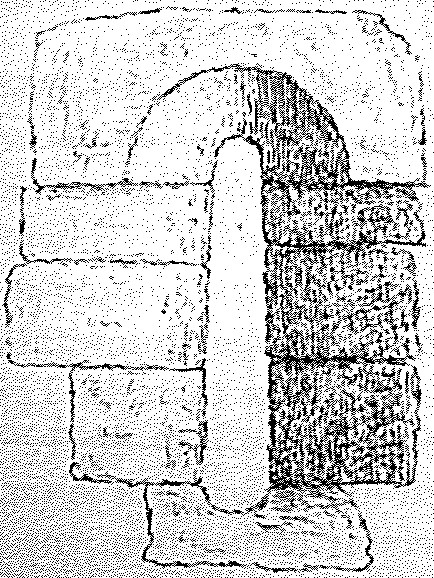
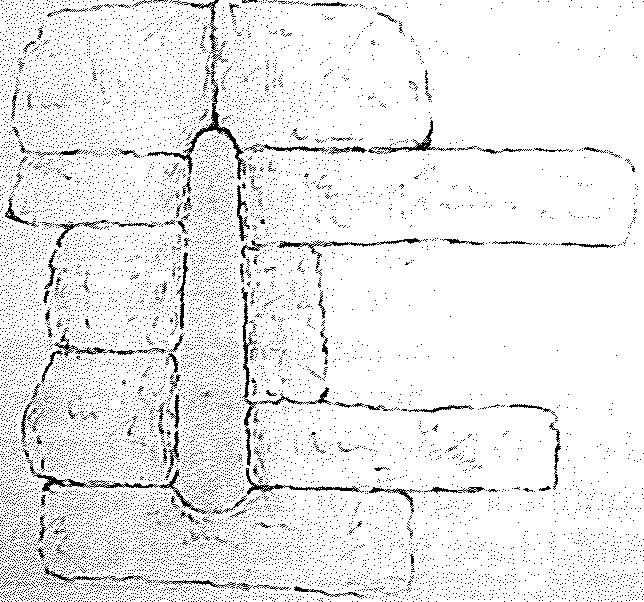
This is exactly like the east window in the church of Kilroe near Killala.
Now it will be asked why is not the doorway placed in the west gable of this church, like the church of Kiltiernan? This question (ninn) can be easily answered; for it will be seen at a glance that the west gable was remodelled at a comparatively modern period, for the south half of it is built of smaller stones and cemented with fresher mortar than the northern half. It will be also perceived at once
that the doorway was originally placed in the middle of it, and that the space which it occupied is filled (patched) up with a mixture of large and small stones entirely different in character from the east gable which was never stirred. It will be also seen at once from the character of the stones which form the doorway in the south side wall that it was inserted at a comparatively recent period, when the doorway in the west gable was stopped up.
This is the third instance of the doorway having been removed to the south wall that I have seen this season, and I incline to think that it became a kind of religious custom in the 12th or 13th century to have the doorway in the south wall. {See my letter on the church of Kilgeever near Louisborough in the Co. of Mayo.}
This church of Cill Eithne is unquestionably one of (built in the) earliest ages of Christianity in Ireland; but as sure as I have eyes to see with, it was remodelled in the 13th or 14th century. No part of it was however touched, but the west gable and south side wall, and the features of these were changed not to enlarge the building, but to make their features agree with a kind of custom {perhaps religious} which prevailed at that period.
I cannot prevent myself from theorizing, for I think it is no harm; but I always make it a rule to prefer that theory which accounts for the greatest number of phenomena to any other; one exception can never destroy a general rule especially in Latin and French Syntax.
In the townland of Caher Errilan in this parish there is a square Castle in good preservation said to have been erected by O'Heyne in whose country it certainly is, as I shall presently shew.
John O'Donovan

